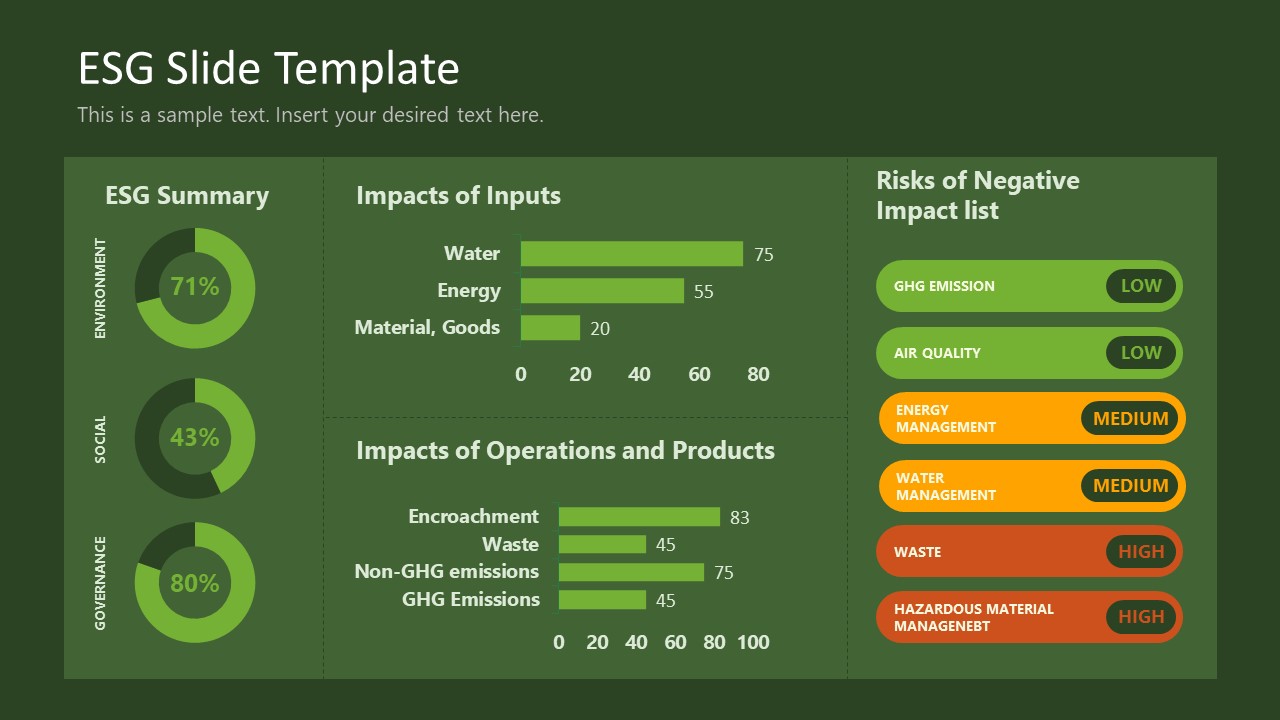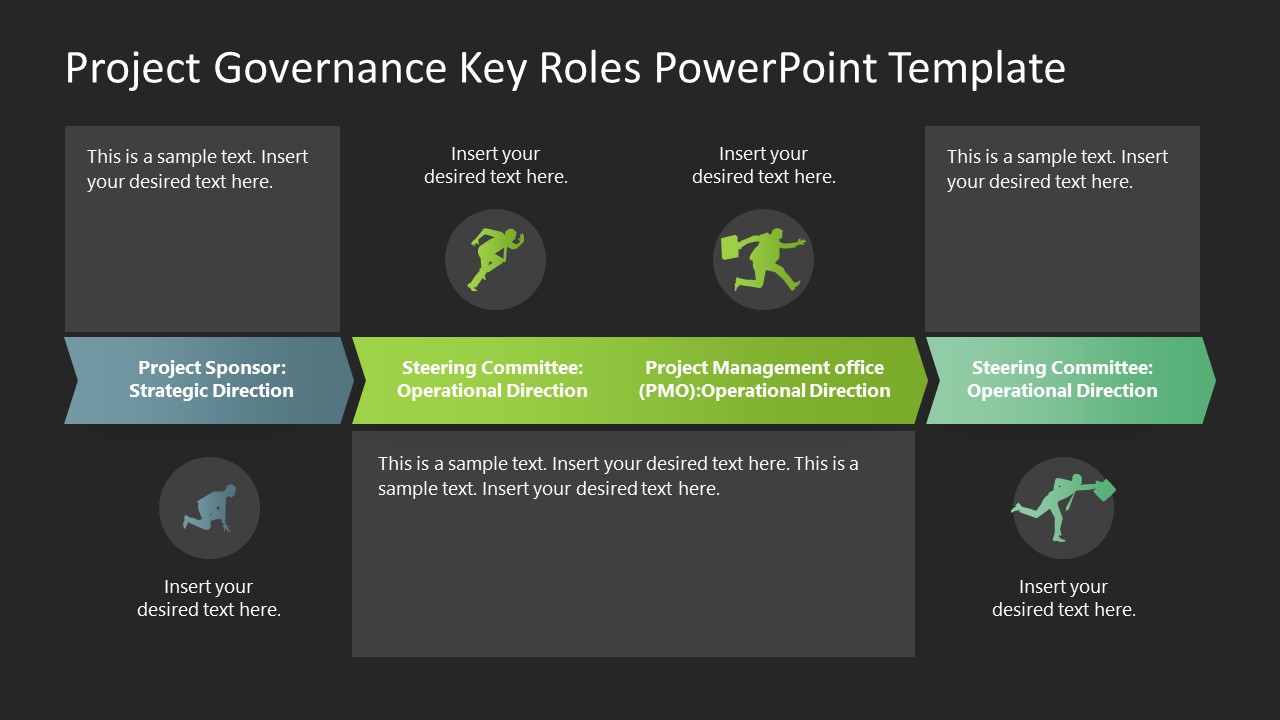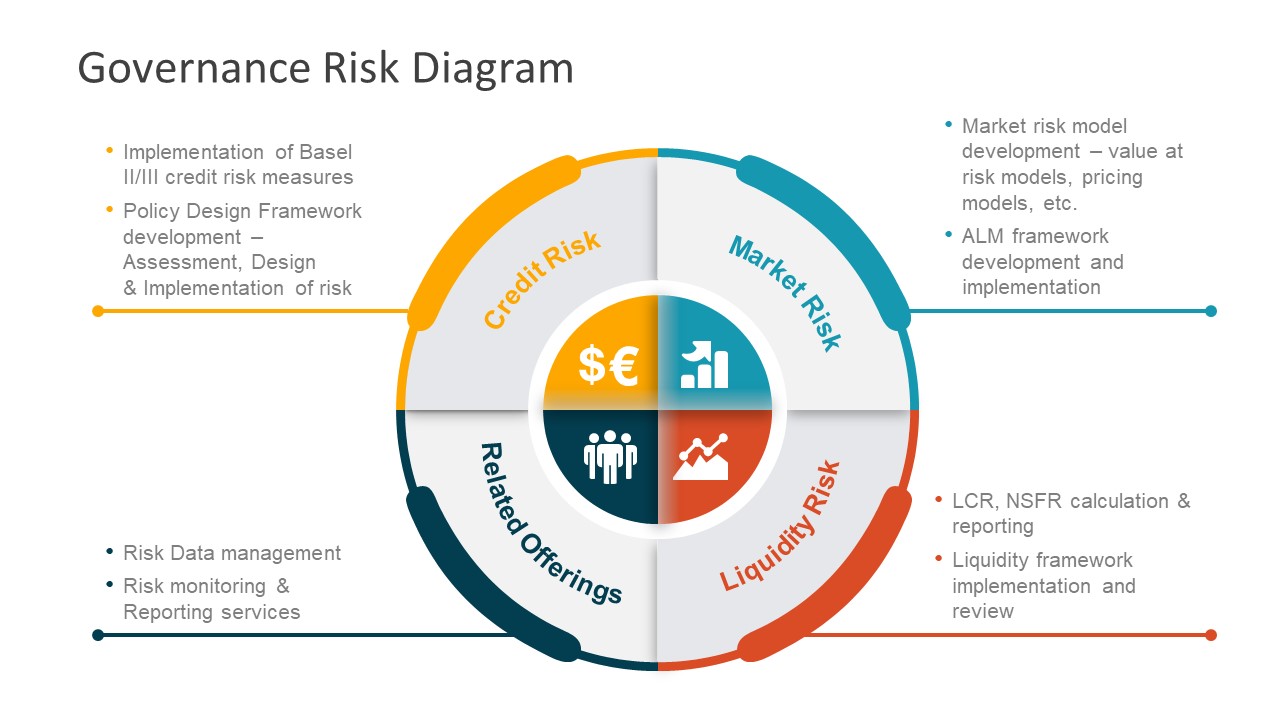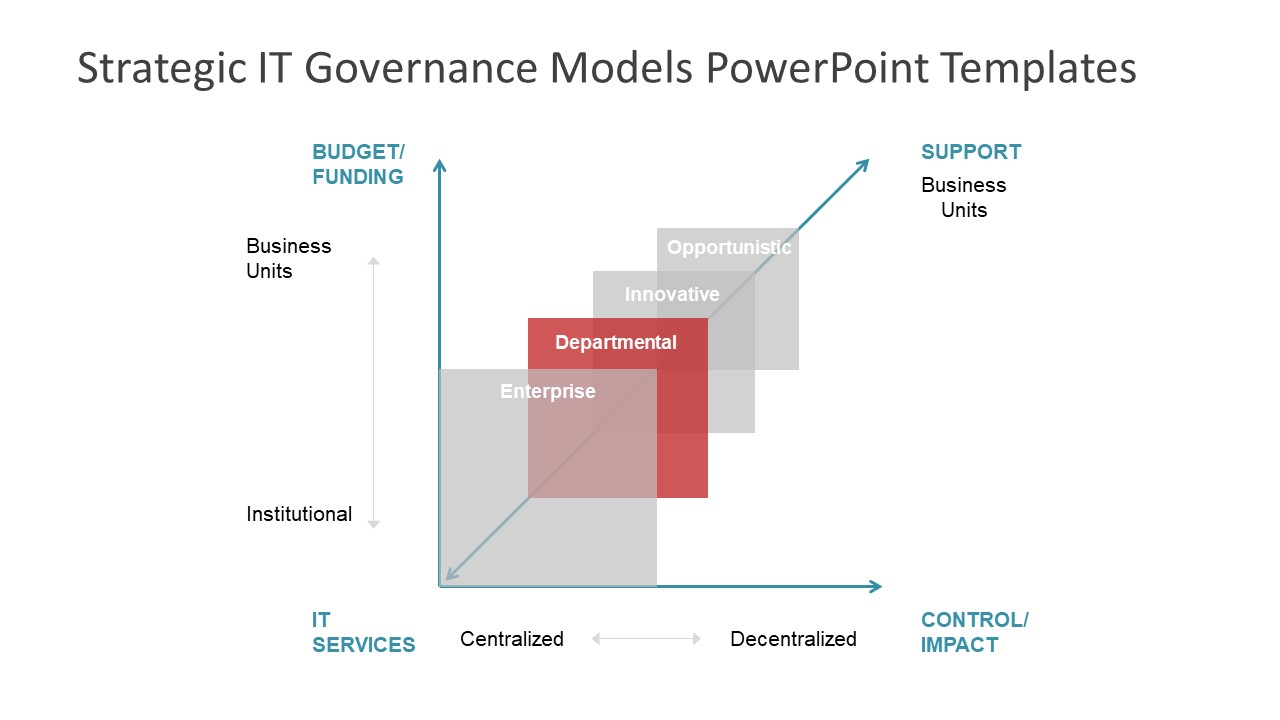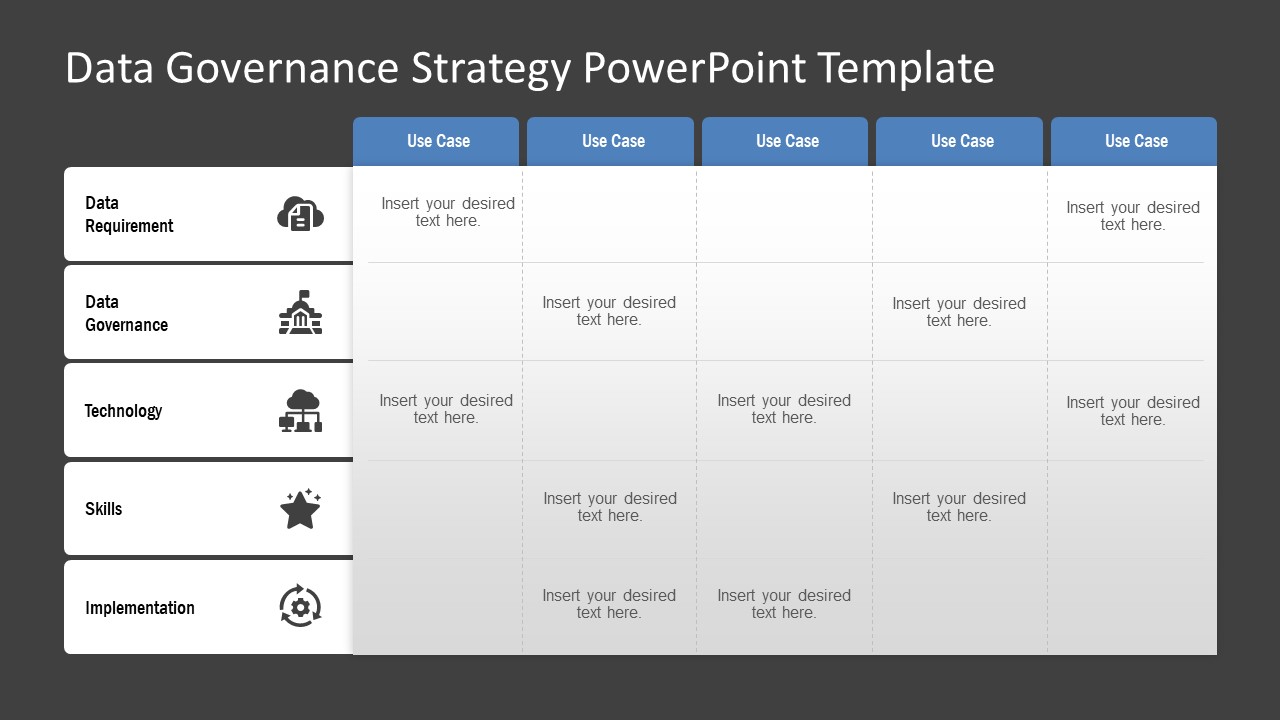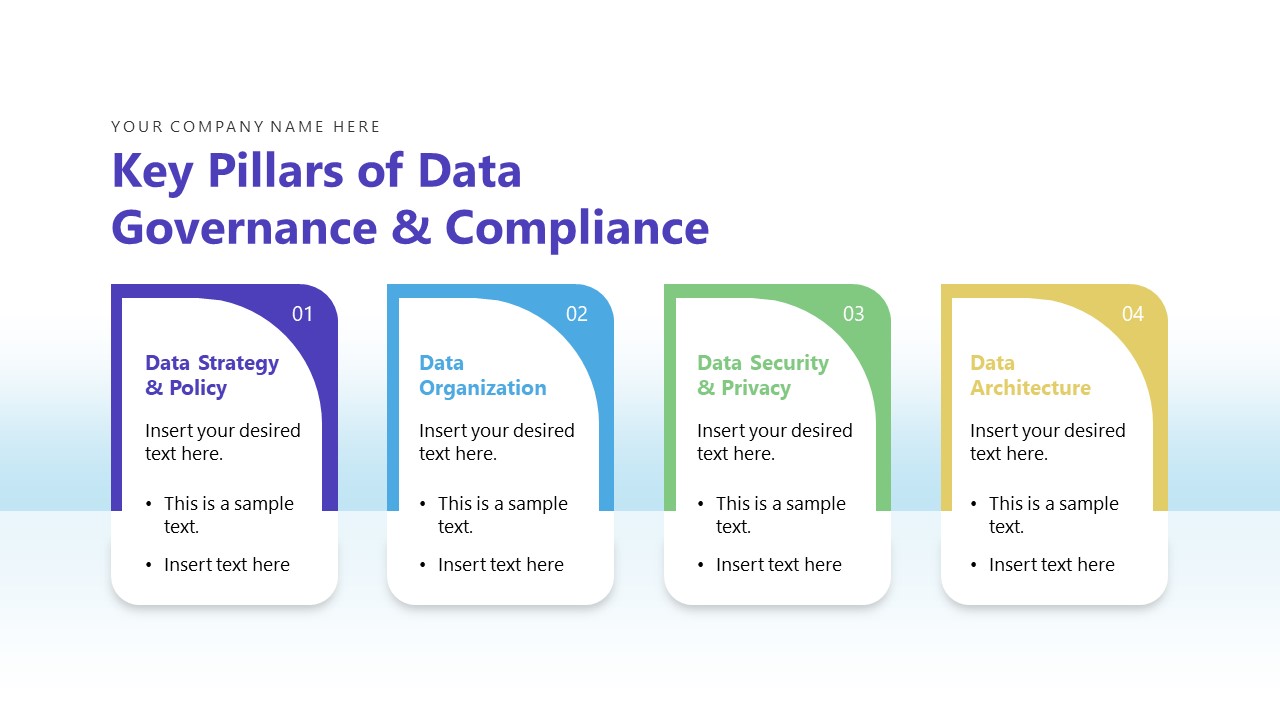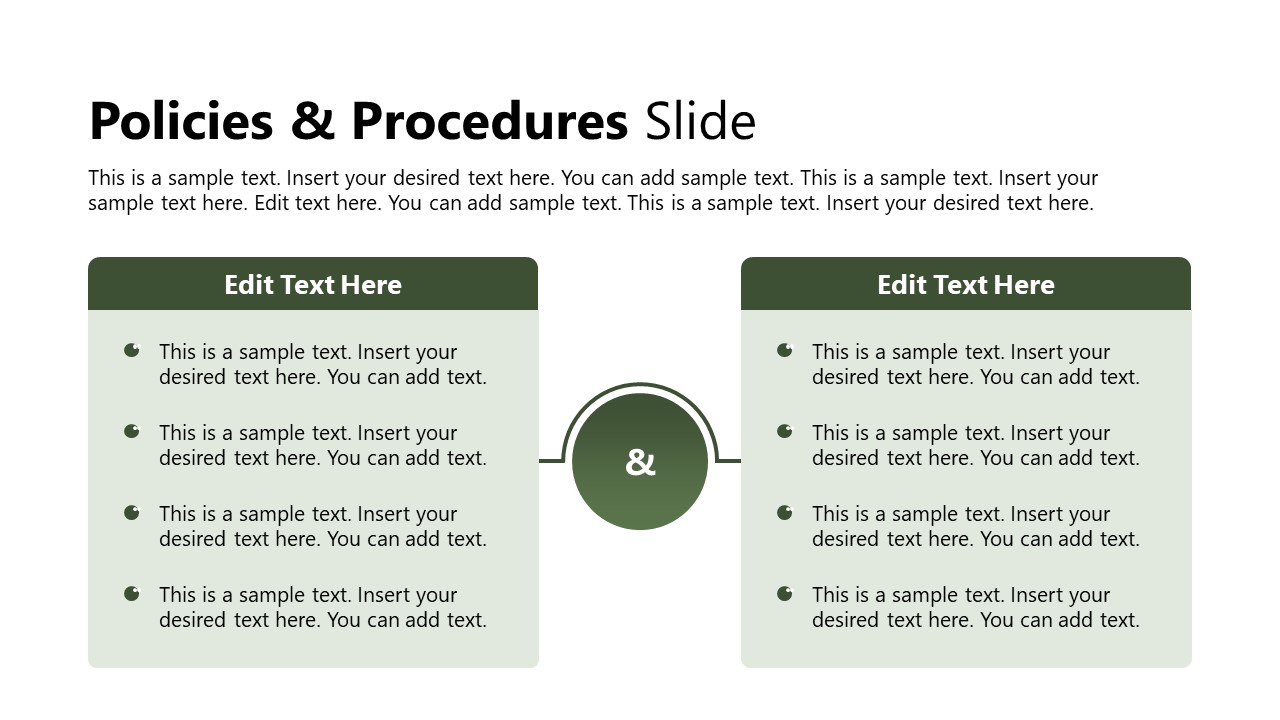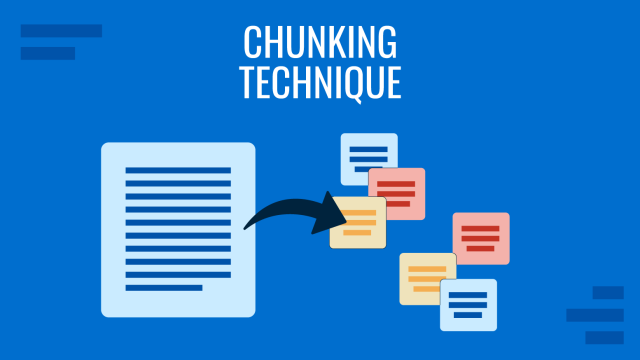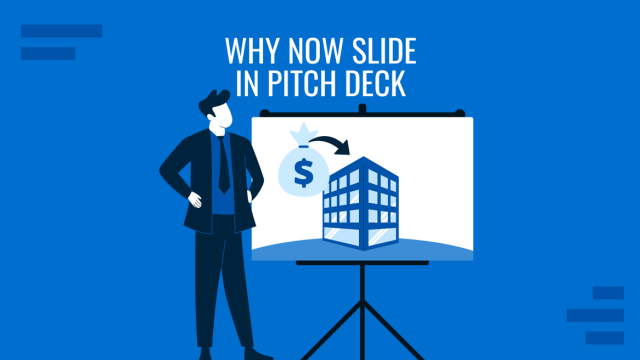
A governance presentation is a strategic communication tool designed to explain how an organization structures its accountability, oversight, and decision-making processes. Whether you’re addressing corporate governance, project oversight, IT governance, nonprofit transparency, or public sector accountability, the objective remains the same: establish trust and alignment. The presentation must clarify what governance means in your organization’s specific context and explain why it is relevant at this stage.
In this article, we’ll explore how to create and deliver governance presentations intended for boards of directors, executives, investors, regulators, or broader stakeholder groups. We’ll use some of the most commonly used types of governance presentations to explain the content to curate for each slide in the deck.
Table of Contents
- Main Types of Governance Presentations
- The Governance Framework
- Organizational Structure
- Governance Processes
- Performance & Oversight
- Stakeholder Engagement
- Challenges & Improvements
- Conclusion in Governance Presentations
- FAQs
- Recommended Governance PowerPoint Templates
- Final Words
Main Types of Governance Presentations
Although all governance presentations are corporate, we can distinguish specific types of governance presentations that have a fixed set of requirements in their presentation structure.
Project Governance
Project governance is the set of processes, roles, and structures that guide project management decisions. It provides a framework to ensure that projects are aligned with the organization’s strategy and deliver the intended benefits.
Core Objectives:
- Define roles: project sponsor, steering committee, and project manager.
- Manage risk, scope, and resources effectively to ensure optimal project outcomes.
- Provide a decision-making framework for scope changes or escalations.
- Ensure accountability for project outcomes.
Unique Features:
Unlike corporate governance, project governance is temporary; it exists only for the duration of the project. It often employs formal methods, such as stage-gate reviews, project charters, and risk logs. Project governance bridges strategic goals and operational execution, making sure projects don’t derail or waste resources.
IT Governance
IT governance is a subset of corporate governance explicitly focused on information technology. It ensures that IT investments support business objectives, manage risk, and comply with regulatory and security requirements.
Core Objectives:
- Align IT strategy with business goals.
- Manage cybersecurity risks, data privacy, and compliance.
- Optimize IT investments and resources.
- Establish clear accountability for technology decisions.
Unique Features:
IT governance often follows established frameworks such as COBIT, ITIL, or ISO 27001. It addresses issues like data security breaches, cloud adoption, and digital transformation. Boards and CIOs implement IT governance to prioritize technology investments and mitigate risks associated with IT failures.
Nonprofit Governance
Nonprofit governance ensures that mission-driven organizations are accountable to donors, beneficiaries, and the public. It focuses less on profit maximization and more on achieving its mission, promoting ethical stewardship of resources, and maintaining transparency.
Core Objectives:
- Protect and advance the nonprofit’s mission.
- Ensure ethical fundraising and transparent reporting.
- Establish accountability to donors, volunteers, and the communities we serve.
- Oversee financial responsibility and program effectiveness.
Unique Features:
Nonprofit boards typically include volunteers and community representatives. There is often a strong focus on fiduciary duty: directors must ensure funds are spent in accordance with the donor’s intent. Governance also emphasizes impact measurement (e.g., how many people were served and how programs improved outcomes). Trust is vital, since nonprofits depend heavily on reputation.
Public Governance
Public governance refers to the systems and processes governments use to manage public resources, formulate policy, and ensure accountability to citizens. It provides transparency, legality, and fairness in the public sector.
Core Objectives:
- Deliver public services effectively and equitably.
- Manage taxpayer funds responsibly.
- Ensure compliance with laws and regulations.
- Promote transparency and accountability to citizens.
Unique Features:
Public governance is broader in scope and complexity. It involves multiple stakeholders: ministries, agencies, auditors, civil servants, and the public. Mechanisms such as public audits, citizen consultations, freedom of information laws, and parliamentary oversight are crucial. Its success depends heavily on transparency and public trust.
The Governance Framework
The Governance Framework section defines the system your organization uses to guide decisions, manage risks, and ensure accountability. This is where you establish the foundation for how governance operates within your specific context, such as general corporate, project, IT, nonprofit, or public.
The presentation deck should begin with a concise definition of your governance model, using one slide to outline its type (e.g., corporate or project) and another to illustrate its principles: accountability, transparency, fairness, and responsibility. Use clear typography and keep text per slide minimal. Reinforce these principles through icon-based visuals; for instance, a balance scale icon for fairness, a magnifying glass for transparency, and a shield for accountability.
Next, include a Governance Framework Diagram, ideally in a layered or circular format. The inner layer represents core principles; the middle layer includes policies (e.g., Code of Ethics, Conflict of Interest Policy, Risk Policy); and the outer layer lists application areas (finance, IT, compliance, HR). Circular diagram templates are well-suited for this purpose because they effectively emphasize the interdependence between governance components.
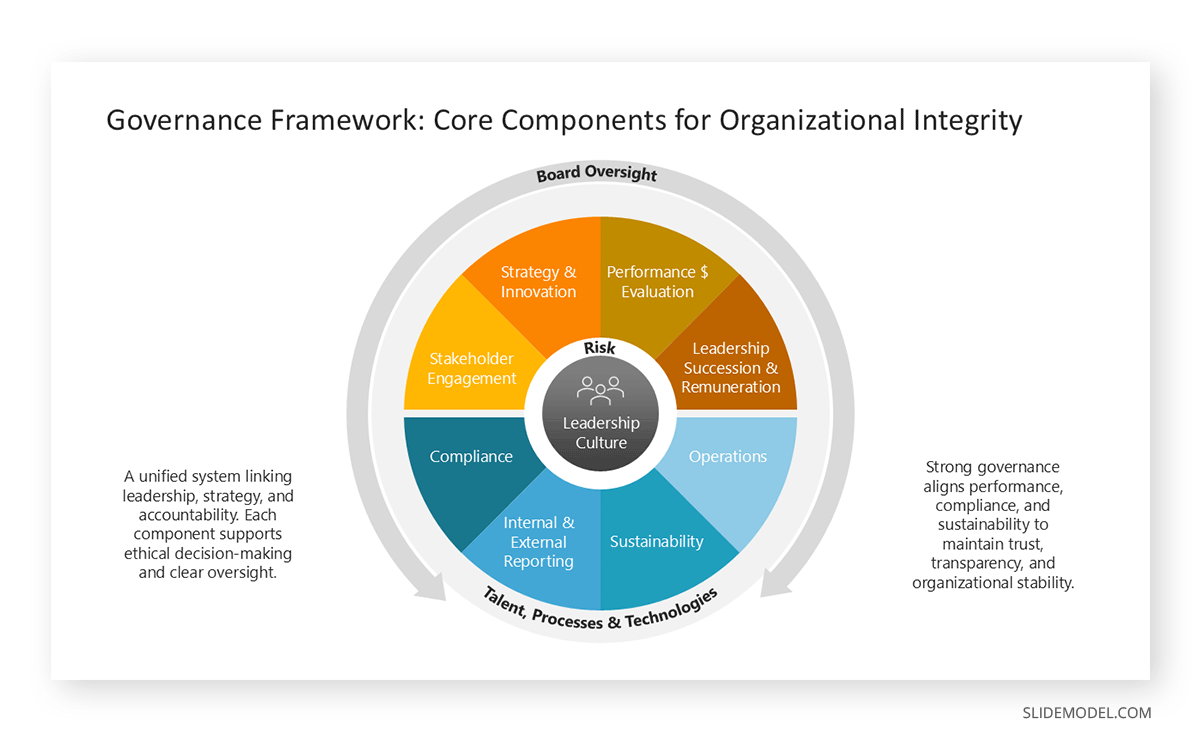
Follow this with a policy slide summarizing key codes of conduct, regulatory frameworks, or standards your organization adheres to (ISO, COBIT, or local compliance laws). A table or checklist visual helps convey adherence efficiently.
Organizational Structure
The Organizational Structure section makes governance tangible by mapping who is responsible for what. Its goal is to show clarity, hierarchy, and accountability across the organization’s leadership and oversight layers.
Start with a Board and Committee Structure slide, created using an organizational chart template, showing the Board of Directors or an equivalent oversight body at the top, with reporting committees below, including Audit, Risk, Ethics, Compensation, and Technology. Use color coding to differentiate between independent and executive members. If relevant, include tenure, expertise, and diversity indicators as subtle infographics to highlight balance and inclusivity.
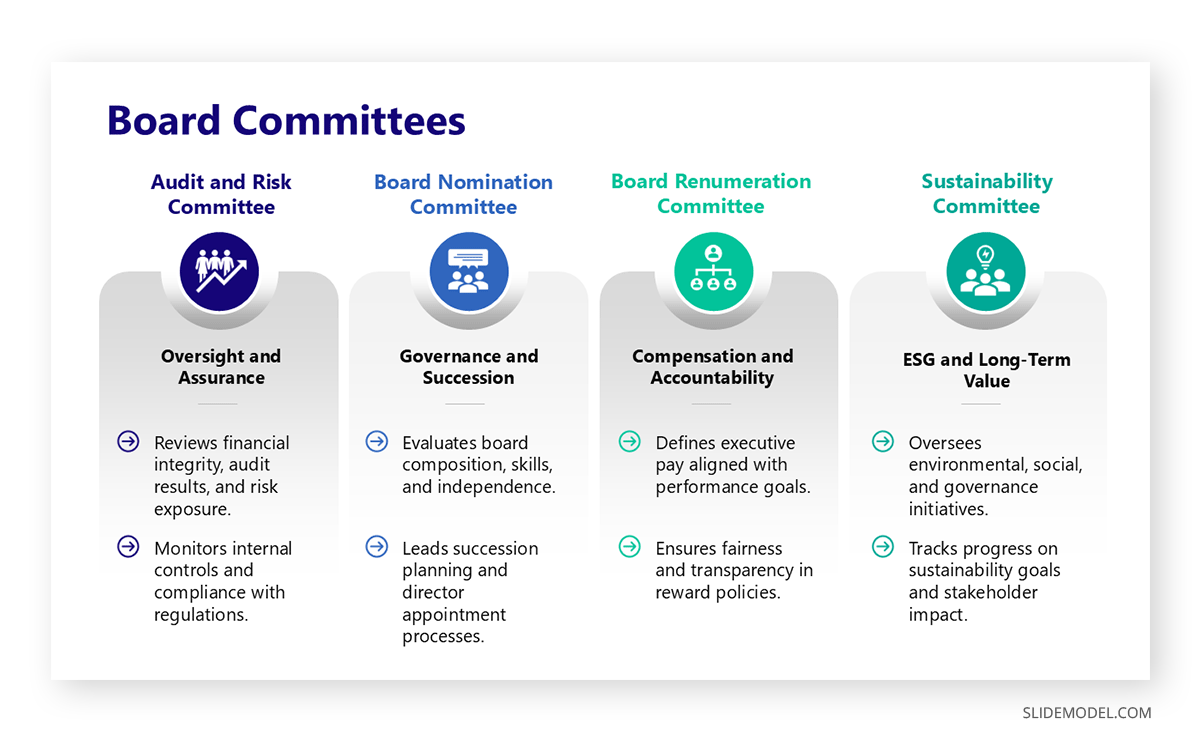
Next, create a Management Structure slide that outlines key executives, their respective functions, and their reporting lines. A dual-column layout (Governance vs. Operations) helps audiences quickly distinguish between oversight and execution responsibilities. If you’re presenting a project or IT governance, include steering committees, sponsors, and delivery teams.
For maximum retention, avoid dense text. Use icons (e.g., gavel for board approval, cog for management execution) and highlight key roles with callout boxes. Animations, used sparingly, can reveal reporting relationships without overwhelming the viewer with sequential information.
Governance Processes
The Governance Processes section outlines how governance operates on a day-to-day basis, including decision-making, risk assessment, and compliance enforcement. This part transforms principles and structure into functional workflows.
Begin with a Decision-Making slide. Use a flowchart PPT template or swimlane diagram to illustrate each step in the approval process: proposal submission > committee review > board decision > implementation > reporting. Distinguish decision stages with color-coded boxes: green for operational approvals, blue for compliance checks, red for escalation triggers. Another alternative is to use a RCVE Prioritization Matrix.

Follow with a Risk Management Framework slide. A Risk Matrix (likelihood vs. impact) helps visualize potential threats and mitigation actions. For corporate or IT governance, this might include cybersecurity risks, financial exposures, or regulatory non-compliance. Include brief descriptors for each risk zone: low, moderate, and high, to make the chart self-explanatory.
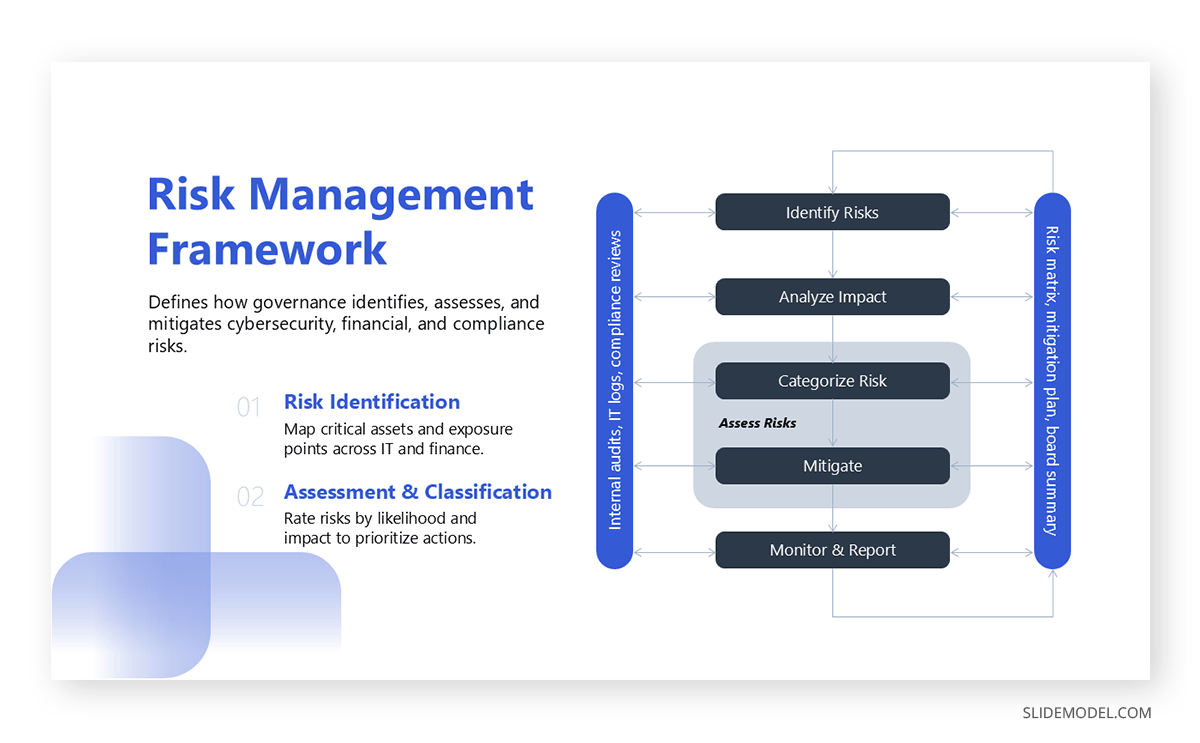
Next, integrate Compliance Oversight visuals. A timeline slide that shows audit cycles, regulatory deadlines, and review checkpoints creates a rhythm and a sense of predictability. Nonprofit or public governance decks can replace this with “Compliance Calendar” visuals to show when major reports (e.g., donor audits, citizen accountability reports) are due.
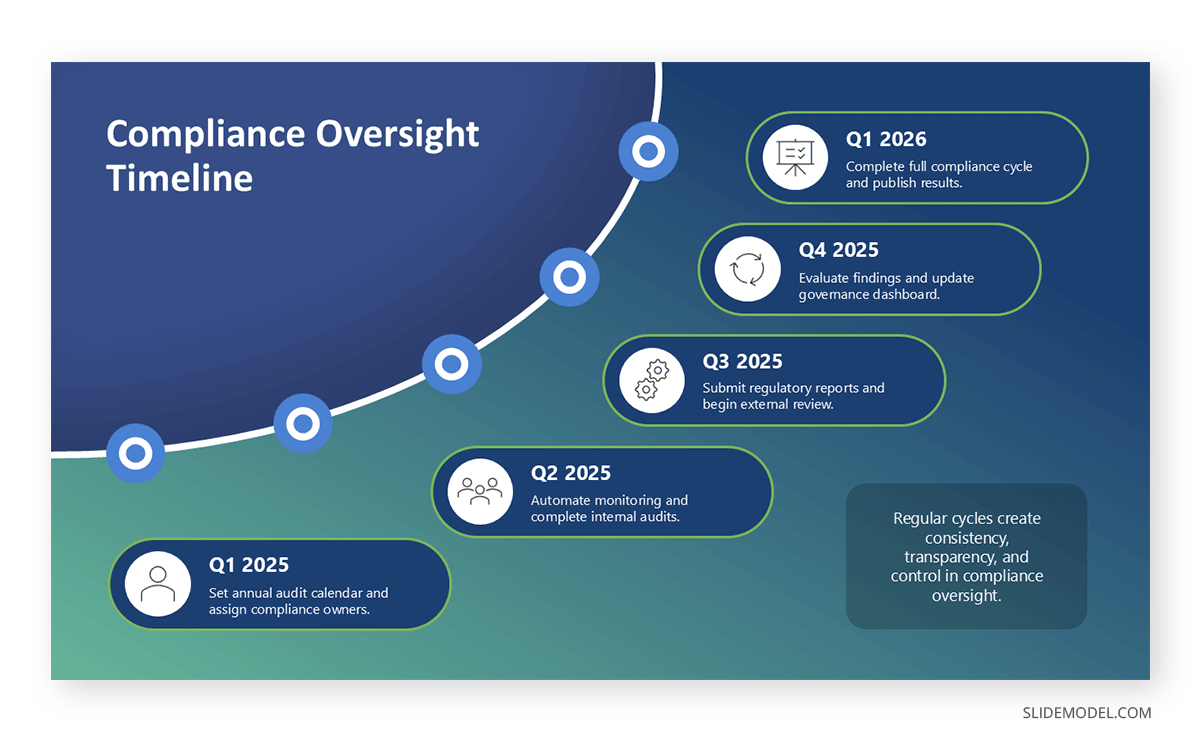
Performance & Oversight
The Performance & Oversight section demonstrates that governance is measurable and actionable. It shows how the organization monitors, evaluates, and continuously improves its governance effectiveness.
Start with a Metrics Overview slide. Present 3-5 key performance indicators (KPIs): board meeting attendance, audit completion rates, compliance incidents, project delivery success, or IT uptime. Use gauge charts, data bars, or simple scorecards to visualize trends instead of long tables. Focus on clarity: green for satisfactory, yellow for caution, red for concern.
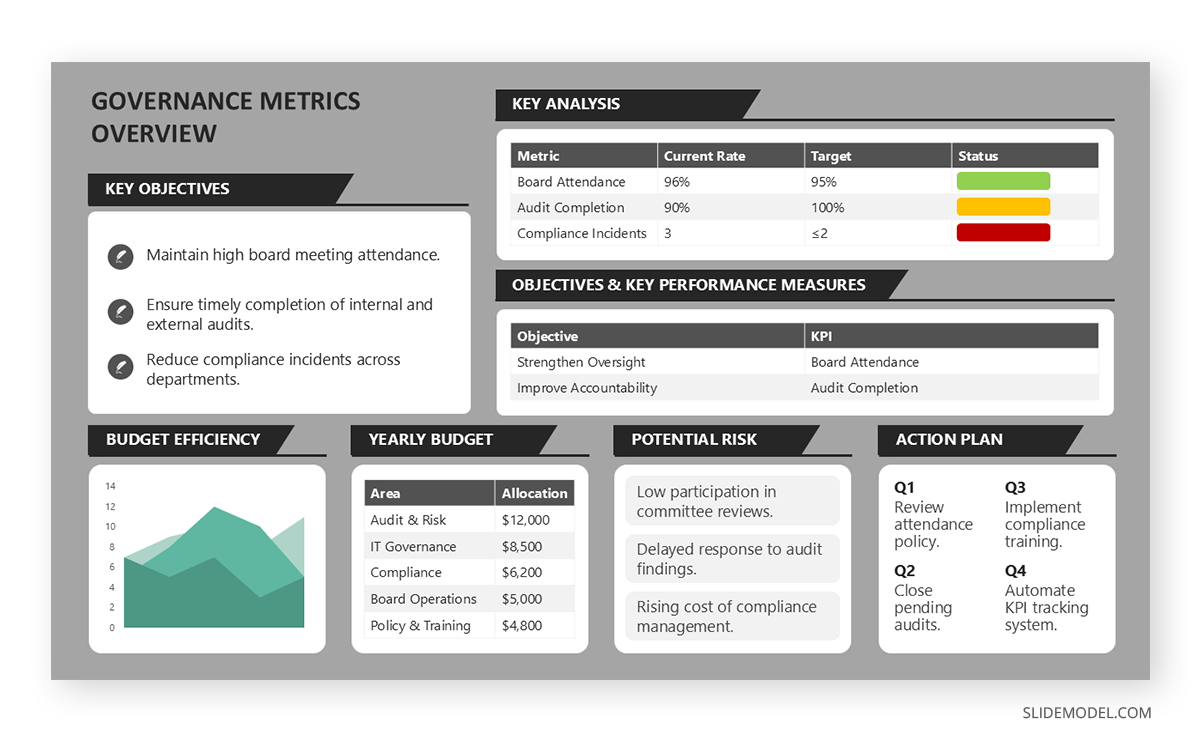
Follow with an Internal Controls slide, outlining key control systems: financial audits, compliance reviews, and ethical reporting mechanisms. A three-column layout is most effective, with the control area, monitoring frequency, and responsible body clearly defined. Add icons (such as a checkmark for compliance and an exclamation mark for an issue) to guide the viewer’s eye.
Include a Board Performance Evaluation slide summarizing how effectiveness is reviewed: attendance rates, decision timeliness, or external board assessments. If possible, show improvements over time through line charts or year-over-year comparisons.
Stakeholder Engagement
Stakeholder Engagement showcases the human dimension of governance: how your organization communicates, listens, and remains accountable to its key audiences.
Begin with a Stakeholder Mapping slide that identifies all relevant groups, including shareholders, employees, regulators, customers, donors, citizens, and beneficiaries. Use a Stakeholder Influence Matrix (influence vs. interest) to classify engagement intensity visually.
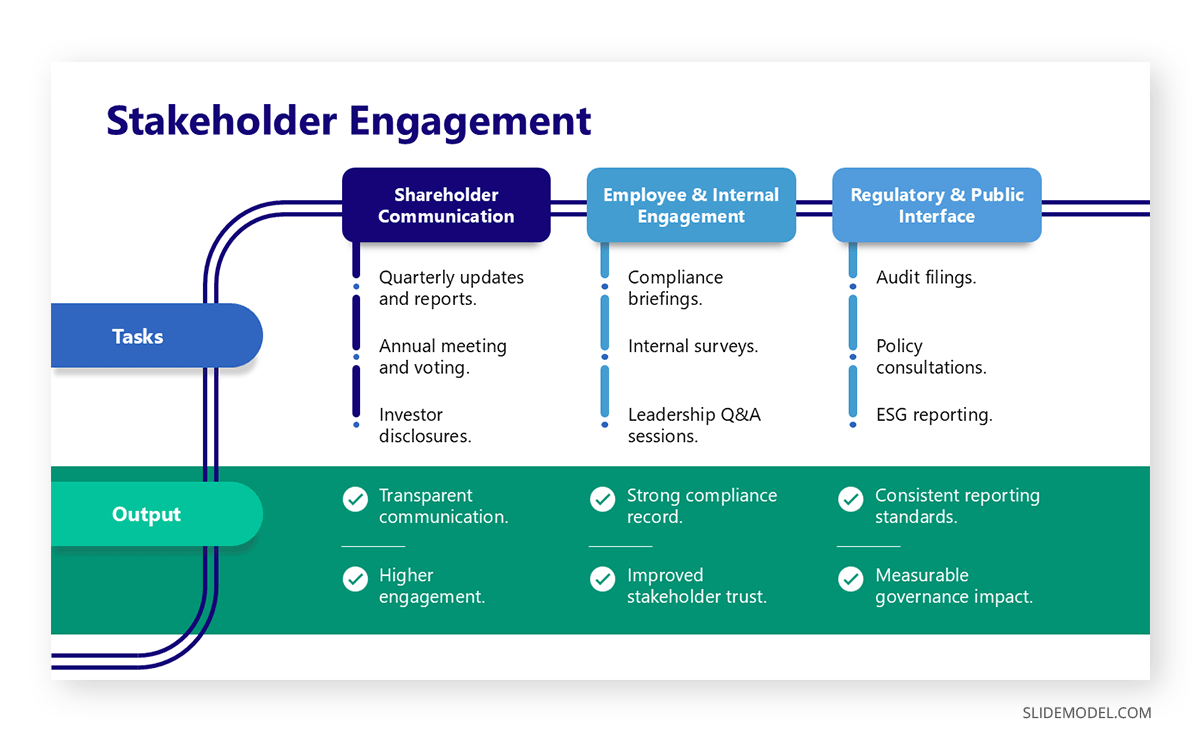
Follow with a Communication Policy slide that summarizes how stakeholders receive updates, including annual reports, town halls, newsletters, and online dashboards. Before diving into specific channels, introduce the concept of a Communication Plan: a structured roadmap that defines what information will be shared, with whom, how often, and through which medium. In governance, the communication plan ensures consistency and transparency by aligning messages with stakeholder expectations and regulatory requirements. It prevents fragmented communication, establishes clear ownership for disclosures, and reinforces accountability through predictable reporting cycles.
A well-designed communication plan distinguishes between proactive updates (e.g., planned board communications or ESG reports) and reactive communications (e.g., issue management or regulatory responses). Incorporating this distinction into your slide helps audiences understand that governance communication is both systematic and responsive.
Using a timeline visual helps show frequency (e.g., quarterly shareholder reports, annual audits, monthly compliance reviews).
If ESG (Environmental, Social, Governance) commitments apply, add an ESG Integration slide showing how governance supports sustainability goals. Use a 3-column layout (E-S-G) with bullet highlights like “Board-level sustainability oversight” or “Transparent carbon reporting.”
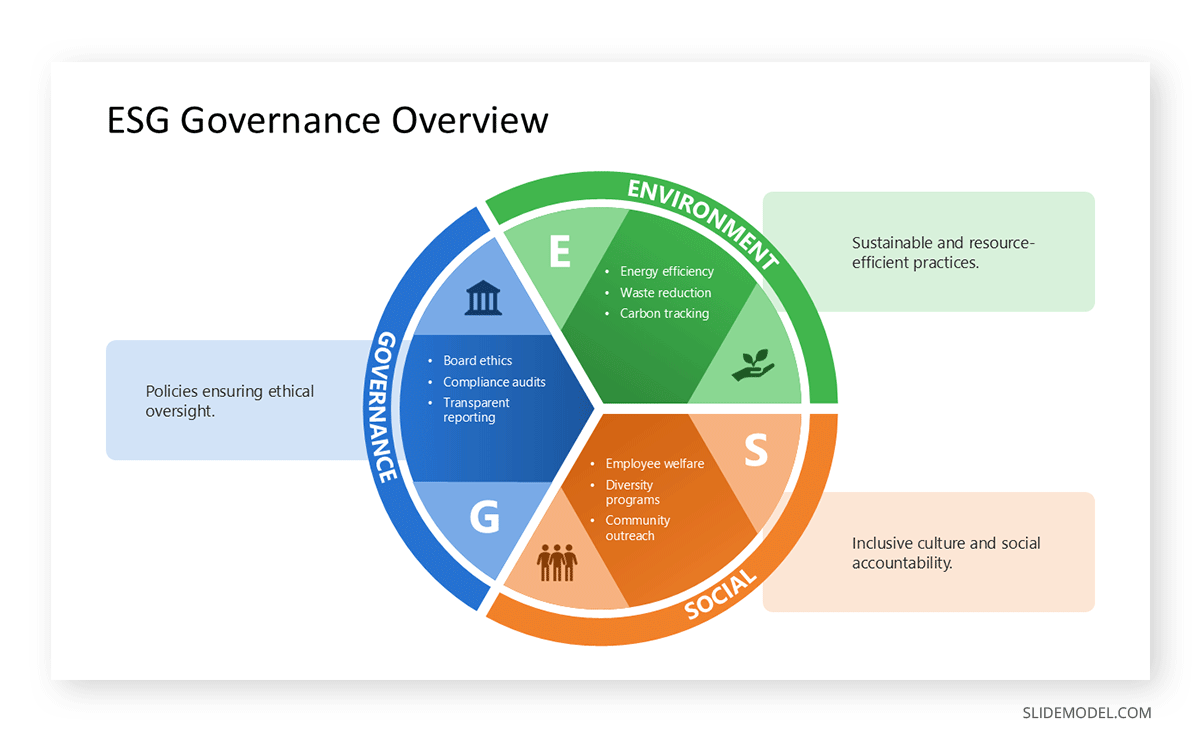
Challenges & Improvements
The Challenges & Improvements section demonstrates self-awareness and commitment to progress. Strong governance presentations acknowledge what’s not working and explain how it will be addressed.
Start with a Current Challenges slide. Use a two-column layout, with the left column for the challenge and the right column for its impact. Typical examples include succession gaps, compliance fatigue, IT security threats, donor retention issues, or political interference. Avoid vague wording; quantify where possible (“Board gender diversity below target 30%”).
Follow with an Improvement Initiatives slide, structured as a roadmap template. Each milestone represents a reform (e.g., “Implement new risk management software Q3,” “Introduce external board evaluation Q4”). Visualize this using a timeline or roadmap template, ideally in a horizontal format, to illustrate progression.
Add a Continuous Improvement Loop slide, showing feedback > action > review > outcome. This reinforces the idea that governance is a dynamic and evolving concept. Circular diagrams or PDCA (Plan-Do-Check-Act) visuals are effective in communicating this concept.
Conclusion in Governance Presentations
The conclusion closes your governance presentation with focus and direction. It must synthesize insights, reinforce key messages, and clearly state next steps.
Start with a Presentation Summary listing 3-5 key takeaways: a governance framework has been established, clear roles have been defined, oversight metrics are being tracked, stakeholder transparency is ensured, and an improvement roadmap is underway. Use concise bullet phrases supported by icons or checkmarks; these act as memory anchors.
Next, include a Next Steps or Action Plan slide. This should specify the decisions required, such as board approval of revised policies, committee endorsement of reforms, or management implementation deadlines. A checklist layout with responsible parties (Board, Audit Committee, CEO) ensures clarity on ownership.
If applicable, include a Call to Action slide addressed to stakeholders, such as: “Adopt the new governance framework,” “Support the digital compliance rollout,” or “Participate in the upcoming evaluation workshop.” The tone should be confident and forward-looking.
FAQs
How long should a governance presentation be?
Aim for 12-15 core slides, similar to those found in board presentations or strategy decks. Appendices can hold detailed reports or compliance documents.
Should governance presentations include financial data?
Yes, especially in corporate and nonprofit governance. Show budget allocation, audit findings, and how resources align with oversight responsibilities.
What’s the difference between governance and management?
Governance sets the direction, rules, and oversight; management executes the strategy within those boundaries. A presentation should clarify this separation.
How often should a governance presentation be updated?
At least annually for corporate and nonprofit boards; quarterly for project and IT governance; and in sync with fiscal or legislative cycles for public governance.
Should governance presentations be confidential?
Internal versions usually are. However, nonprofits and public bodies may publish summary decks for transparency.
What’s the role of stakeholders in governance presentations?
Stakeholders provide accountability. Presentations should demonstrate how input is gathered, processed, and disclosed.
Recommended Governance PowerPoint Templates
Corporate governance presentations often need to make structures visible. Boards, committees, and reporting lines can easily overwhelm stakeholders if explained verbally. In this section, we’ll review a selection of governance PowerPoint templates intended to help you create a professional-quality governance deck in minutes. Alternatively, we invite you to try our AI-presentation maker tool, SlideModel.ai, as it can provide you with a vast range of tools to quickly generate a governance presentation deck, which can be further customized in PowerPoint or Google Slides.
Final Words
A governance presentation is a statement of order, purpose, and responsibility. It connects the rules, roles, and mechanisms that guide how an organization is directed and held accountable. Each element within it, the framework, structure, processes, and oversight, serves to clarify how decisions are taken and how integrity is preserved in daily operations.
Presenting governance is an act of transparency. It allows stakeholders to see the systems that sustain trust, define authority, and ensure continuity. Through clear information and consistent reporting, governance becomes a shared understanding between those who lead and those affected by those decisions.
